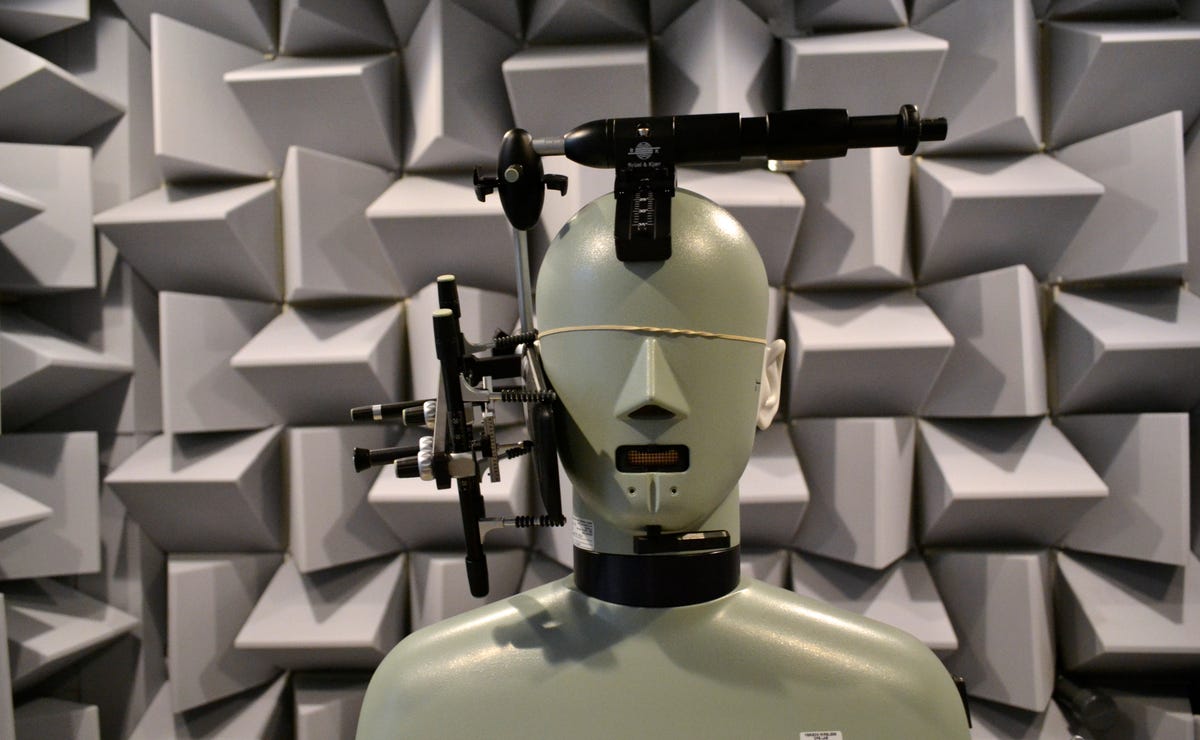
Ben Fox Rubin/CNET
BEDMINSTER, NJ — “Welcome to the quietest room in this building,” Sherif R. Sherif said.
The manager at Verizon’s device-testing lab stood at the center of a small room with a grated floor and triangular foamy, gray spikes lining the walls and ceiling. Right next to Sherif is the head and torso of a gray mannequin whose rubbery ear is strapped to a cell phone. The echo-free room, known as an anechoic chamber, is used to test a smartphone’s speaker and microphone and is eerily silent. A sudden noise, like clapping your hands, will die completely just after it’s made. The space is even built on springs to diminish the rumblings from trucks along a nearby highway.
It’s here, deep inside one of the wireless carrier’s New Jersey campuses, that Verizon reviews smartphones in a dozen testing rooms protected by large steel doors, representing the last stop before phones, tablets and other connected devices can reach Verizon’s retail stores. After thousands of test cases in the lab, the field and by trial users, if a phone isn’t up to snuff, it won’t be approved to run on the carrier’s network.
“You can have the best network in the world, but it doesn’t mean much if the device doesn’t work,” said Mike Haberman, Verizon Wireless’ vice president of network operations.


Ben Fox Rubin/CNET
Verizon showed off the lab space this week to a handful of reporters in an effort to emphasize some of the behind-the-scenes work it puts into its call and network quality. Such testing labs may not be the flashiest part of any wireless carrier’s operations, or the one customers generally think about when shopping for a phone, but they serve a critical function to making sure that when you get a phone, it does its job.
It’s never been more vital for that phone to work, and work well. Verizon has long banked its reputation on network superiority, but over the last year, rivals have chipped into Verizon’s perception as the nation’s premier carrier. AT&T, the second largest player behind Verizon by subscriber base, touts the nation’s most reliable network, just like Verizon. T-Mobile claims its network is faster.
Verizon, for its part, maintains that it offers a better service than the competition.
“It still is our strength and still will continue to be our strength,” Haberman said of the company’s high-speed 4G LTE wireless network, noting that Verizon offers broad 4G coverage throughout the US, not only in cities and suburbs. “We still hold an advantage over there.”
This week’s visit also coincided with Verizon’s four-year anniversary of rolling out its 4G network, having launched four years ago on Friday. That network first came to nearly 40 markets in 2010 and it was largely completed last summer, reaching over 500 markets. Verizon plans to lead the way with 5G too, but that technology likely won’t come about until after 2020, Haberman said.
Dropping in on dropped phones (pictures)






While the anechoic chamber makes for a cool visual, it isn’t unique. Similar testing facilities are found at other carriers, as well as many of the major handset manufacturers who also conduct their own evaluations. Still, Verizon has a reputation for conducting one of the most stringent battery of tests in the industry.
In another testing room, Sherif demonstrated what it was like to introduce background noise while making a call. Using speakers at the corners of a windowless white room, testers piped in the sounds of static noise, a bustling restaurant and a train station. Amid the cacophony, another head-and-torso mannequin attempted to say “Harvard sentences,” a standard set of phonetically balanced phrases often used to test phone quality. “The boy was there when the sun rose…A rod is used to catch pink salmon…The urge to write short stories is rare,” the mannequin droned, switching between male and female voices.
It was difficult to hear the phrases from within the room as the speakers blasted out noise. But outside, hearing the voices on a smartphone, much of the sounds in the background were eliminated. The mannequin’s phone wasn’t at all special, Sherif said — it’s the standard Verizon uses for all its devices.


Ben Fox Rubin/CNET
Technology manager Steve Manetta, who reviews hardware reliability, made a call using a smartphone, then put it in a tumbling machine that dropped the device over and over again. In a nearby machine, he set up fixed, one-meter drops of a phone, on its side and glass face, onto a steel surface.
“Falling apart’s fine. Little nicks and dents — that’s fine,” Manetta said, referring to a phone’s back plate and battery coming apart from a fall.
However, if at any point a call drops during testing or parts of the phone stop working, a device could be flunked. Manetta said the hardware team uncovered a problem with one device maker’s phone, in which the earpiece stopped functioning after sustaining a few drops. (For competitive and partnership reasons, Verizon avoided mentioning specific manufacturers.) Luckily, the problem was a relatively easy fix. In many cases, a device maker will come to the lab or be in regular touch with Verizon testers to make sure any major problems can be uncovered well before a phone goes into mass production. Such issues aren’t the norm because of advanced tests conducted by the manufacturers.
As phones become more and more complex and are used for more daily functions, these kinds of testing labs should become even more important, helping avoid someone’s device malfunctioning — which can be embarrassing for both the device maker and the carrier.
“There’s nothing worse than when you get something and it’s buggy,” Haberman said. “We continue to invest resources in [testing], because you want the phone to work. You can’t use the excuse that it’s too complicated.”



